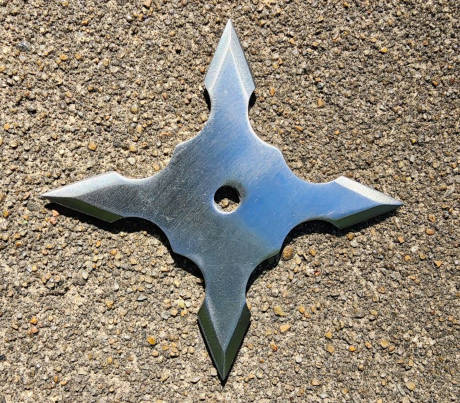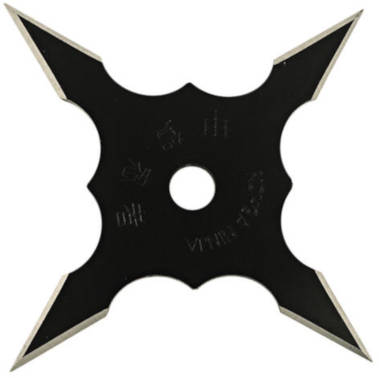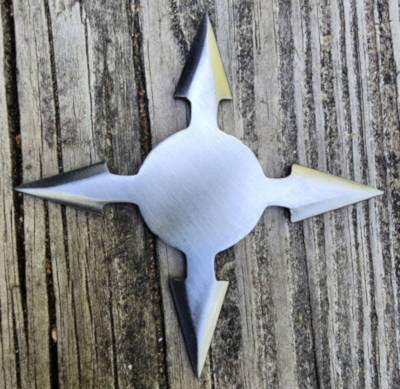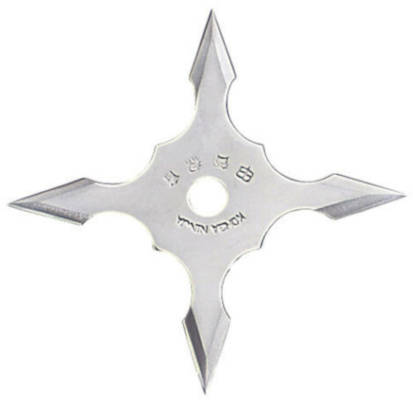Secrets of the Juji Shuriken

Ah, the Juji Shuriken, the mysterious ninja weapon of Japanese lore. So few have unlocked its secrets, so little is known about its use. Let us unravel the mysteries together and discover the lost art of this ancient artifact!
In this comprehensive guide, I’ll guide you through the history of the Juji Shuriken and its various forms, we'll learn how to wield and utilize the weapon properly, and how to recognize its various markings and historical significances. After reading this guide, you'll finally unlock the hidden knowledge contained within the Juji Shuriken, and gain an intimate understanding of the history and lore surrounding this ancient weapon.
So, if you’re ready to unlock the secrets of the Juji Shuriken, sharpen your kunai and fire up your tanto…let’s get started!
Origins and Usage of the Juji Shuriken
The Juji Shuriken, also known as the “Cross Shuriken” or the “X-Shaped Throwing Star”, has become a weapon of popular culture for its undeniable beauty and mystique surrounding its origin and usage. Although there are many theories about where this interesting tool originates from, such as Japan or China, it is generally accepted that the Juji Shuriken was likely invented in Japan during the Edo period (1603-1868).
The Juji Shuriken functioned as a throwing weapon that would spin rapidly through the air at its intended target. It was created to have four sharp tips in order to pierce any armor worn by the opponent. In addition to combat use, the Juji Shuriken also acted as a piece of exercise equipment for martial arts training. Proponents of this practice argue that training with the Juji Shuriken not only improved visual acuity, hand-eye coordination, and mental focus, but it also helped hone the timing and precision required for martial arts fights.
Traditional 4 Point Shuriken
In terms of battle use, opponents claim that this type of shuriken was not designed for combat alongside swords and spears due to its light material and lack of penetrating force. However, supporters point out the role it had in surprise attacks against larger forces due to its rapidity and long-range accuracy when thrown in groups. This can be supported through examples such as ninja engaging in surprise tactics using shuriken to gain an advantage over their enemies in close quarters.
Though its precise origins may forever remain cloaked by mystery, one thing remains certain - The Juji Shuriken has been used throughout history as both an effective martial arts training tool and a lethal battlefield weapon. To uncover further secrets behind its usage and purpose, we must now venture into its application outside military contexts and explore how it can facilitate physical and mental discipline when executing martial arts techniques.
From Martial Arts Training to Battle Use
The Juji Shuriken has a long history of being used in martial arts training, but debate remains on whether it should have been used in actual battles. There are valid arguments that stand on both sides of the debate.
On one hand, some claim that evidence proves that this unique throwing star was more than capable of being utilized effectively in battle scenarios. Several historical texts recount accounts of Juji Shuriken being wielded with success against swords and other weapons due to its deadly sharp edges and long spikes. Its versatile shape also made it easier to handle among samurai warriors during intense combat settings, allowing them to keep their distance from danger yet still attack enemies with precision and speed.
On the other hand, there are those who say that Juji shuriken were actually designed for training purposes, rather than for its use as a weapon in combat. Unlike regular throwing stars which are usually flat and two-dimensional, this style of throwing star can be three-dimensional, as each arm is curved outwards from the center which creates an X-shape. This design makes it inherently more difficult to be thrown accurately at a target compared to regular throwing stars, making it ideal for training exercises rather than actual combat situations. Because of this difficulty level, many experts believe that any claims of its usefulness in battle must be taken with a grain of salt.
No matter which side of the argument you fall on, one thing is for certain: these X-shaped throwing stars have remained popular throughout various cultures and countries over the centuries due to their interesting shape and design. In our next section we will take a closer look at exactly how these traditional bladed works were constructed and why they remain popular today.
Design and Traditional Bladework
Design and traditional bladework are integral parts of Juji Shuriken, the ancient claw-shaped throwing blades. While many martial arts students recognize the ninjutsu-associated weapon from movies and video games, its history dates back centuries to when warriors used them in combat. The sharp four-pointed ends of the shurikens were designed to puncture armor or cause lethal wounds if they stuck into an opponent’s flesh. We should bear in mind that shurikenjutsu was always a last resort - something desperate ninjas resorted to when all other means had failed and their lives were at stake.
The traditional method of making shuriken used blacksmithing techniques with iron flecks from clay as part of the blade. This method undoubtedly produced sophisticated and effective blades, but they are difficult to replicate without professional help due to the special materials used. A modern artist can replicate something that looks similar but won’t be able to produce a truly authentic or viable weapon in battle. It’s understandable why modern martial artists avoid using traditional bladework in re-enactment duels since it would be unsafe and potentially dangerous.
From this analysis, we can see that although designing Juji Shuriken is both fascinating and challenging – it must also be handled with care by taking safety precautions into account. Considering its historical background as a martial arts weapon and its strong design features, the study of Juji Shuriken provides a deep insight into historical combat tactics and techniques – one which will now be discussed further in terms of effectiveness as an actual weapon versus those depicted in popular culture.
Effectiveness as a Weapon
The effectiveness of the Juji Shuriken as a weapon is debatable. On one hand, some experts argue that its unique design makes it a much better weapon than its contemporaries such as the bo-shuriken and kunai. Supporters of this view point to its four-fold shape which provides stability during flight and makes it more likely to remain in one piece on impact. They also note its ability to rotate while in flight, adding another aspect of precision that can make it invaluable in stealthy combat situations.
Modern Design of the Juji Throwing Star
On the other hand, some experts are less optimistic about the Juji Shuriken's potential when used as a weapon. Critics of the design argue that while it might have an interesting shape, its construction make it inferior in flight due to its thinner blades than both the Bo-shuriken and Kunai.
Despite these critiques, there is no denying that Juji Shuriken are still incredibly versatile weapons and have been embraced by modern day ninja practitioners across multiple disciplines. With their signature shape and unique aerodynamic properties, Juji Shuriken allow ninja warriors to have greater control over their thrown weapons in ways that no other traditional shuriken can match.
Furthermore, many authorities agree that practitioners of this art must be mindful of not just admiring their history and appreciating the craftsmanship but rather truly understanding its limit and use cases so they can become proficient at wielding them when necessary situations arise. With this information under their belt, martial artists interested in mastering the skill set of ninjutsu should focus their attention on developing solid throwing techniques based on the valuable lessons learned from Juji Shurikin.
Now, with a better understanding of how Juji Shurikin works and performs as a weapon, we must measure it up against other Ninja weapons.
Measuring Up to Other Ninja Weapons
Given its simple design and small size, the juji shuriken is commonly compared to other weapons favored by ninjas. While it may not be as powerful as a sword or a jumonji yari, it does have several advantages over them in terms of speed and stealth. Moreover, many experts believe that this little-known weapon can be especially effective when used in close combat against an unsuspecting foe.
At the same time, it is accepted that the juji shuriken is limited in its ability to deliver fatal blows in comparison to more prominent ninja weapons such as the ninjato. However, samurai masters such as Miyamoto Musashi recognized its potential as an assassin’s tool--a virtue that cannot be underestimated. With its ability to pierce armor at close range, the juji shuriken shattered many lives during Japan's Age of Warring States.
No matter if compared to its peers or not, there is something special about the juji shuriken. As our journey through history continues, we'll uncover how this noble metal object has shaped our world for centuries--signifying a spirit of resilience and ingenuity.
Historical Impact of the Juji Shuriken
The Juji Shuriken has made a lasting impact on history due to its unique design. During the Edo period in Japan, Juji Shuriken were usually only used by ninja clans and later became popularized by the Koga Ninja Clan during the Sengoku period. During this time, these distinctive throwing stars were used for assassination missions, espionage, and sometimes even defense.
The use of Juji Shuriken continued throughout history even after ninja clans went extinct. It eventually became less of a tactical weapon and more of an item associated with martial arts culture as it is today. Of course, there are debates amongst scholars about how effective the Juji Shuriken truly was in comparison to other weapons used by ninjas and samurai warriors at the time. Regardless, its historical impact has been significant enough for it to be remembered centuries later.
In the next section we will explore how ninjas and samurai warriors actually made use of the Juji Shuriken both practically and tactically in their operations. With this knowledge, we can gain insight into how one seemingly simple weapon helped shape Japan's ancient past.
Main Points to Remember
The Juji Shuriken was a unique weapon used by ninja clans that had advantages over traditional weapons like swords and bows due to its aerodynamic shape and ability to penetrate solid objects. It was used for assassination missions, espionage, and even defense. Over time, it became more associated with martial arts culture than as a tactical weapon, but its historical impact is still remembered centuries later.
Ninjas and Samurai Warriors‚ Usage
The Juji Shuriken has deep roots in the history of Japanese martial arts, and it is often associated with ninjas or samurai warriors. Ninjutsu, or the art of ninja made use of the Juji as a unique and powerful throwing star weapon that was used to surprise and disarm opponents. Some suggest that ninjas only used these weapons, while others mention their use by samurai warriors as well.
Most accounts agree that both kinds of fighters incorporated this throwing star into their arsenal for essentially the same reasons: to surprise and harm opponents from a distance when customary swordsmanship failed them. Moreover, this shuriken offered the advantage of concealment since it required very little space and could be hidden in clothing until needed.
It is also described how two similar methods were employed for throwing this weapon accurately: one method thrusting with great speed, while a second method required calculated arcs to hit targets from behind obstacles. Thus it can be argued that a skilled user made use of both techniques depending on what worked best in each situation - a difficult feat met only by experienced fighters.
Silver Colored Juji Star
There is much evidence to back up theories regarding ninja and samurai usage of the Juji Shuriken. Historic sources such as ancient legends written in Japanese folklore tell tales of samurai struggling against enemies while using the star-shaped device to cause distress, surprisingly even when engaged in close combat. Additionally, victims during feudal Japan suffered deep cuts on their bodies consistent with being inflicted by a ninja's blade, believed to have sometimes been a Juji Shuriken.
Overall we can conclude that whether used by ninjas or by samurai warriors, the Juji Shuriken has had an important place in Japanese martial arts. It certainly has been an interesting part of determining tactics and strategies for many decades past – something modern-day practitioners still aim to understand today.
Answers to Frequently Asked Questions
How is it used?
A juji shuriken, also known as a "cross-shaped throwing star", is an ancient tool used for long-range combat in the martial arts. Historically, it was a type of throwing weapon used by ninjas and other martial artists to strike their opponents from a distance. It is primarily used for projecting sharp blades outward in order to inflict injury or pain at a target. This versatile weapon is still used in modern martial arts as well as in ninjutsu training.
What is the history of the juji shuriken?
The juji shuriken is one of the most iconic and recognizable traditional Japanese weapons. It dates back to the Edo period of Japan in the 1600s and was used primarily by ninjas as a throwing weapon or projectile. In modern times, the juji shuriken has been reinterpreted and reimagined in many forms, from video games to movies and TV shows. However, its heritage remains firmly routed in its function as an effective and important weapon within ancient Japanese culture.
Add your comment now!
Post Comment


